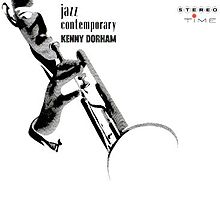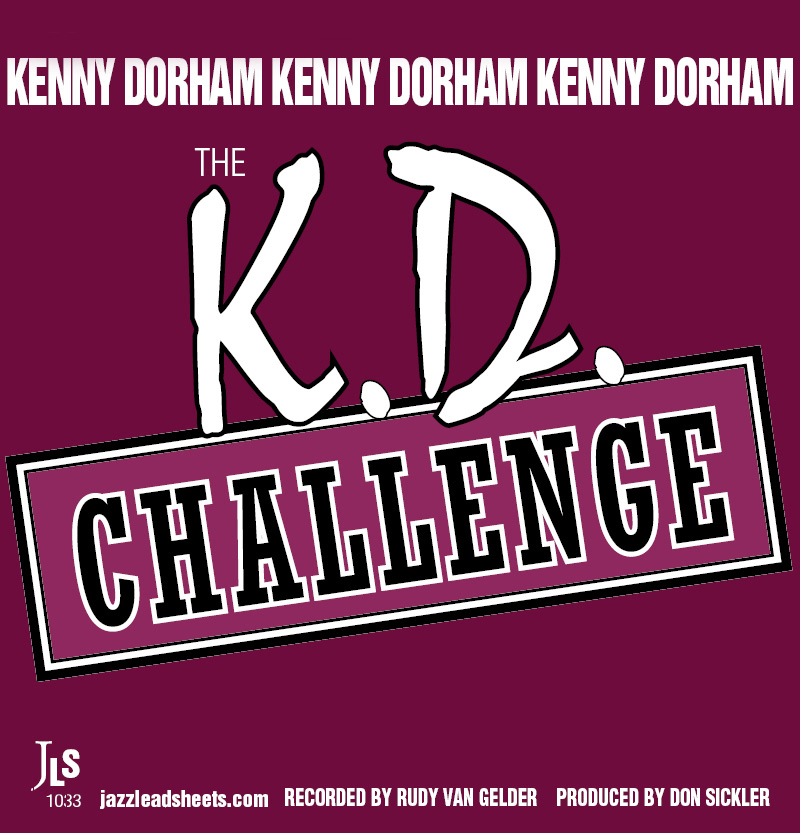Horn Salute – Kenny Dorham
A very intriguing Kenny Dorham composition, with lots of question-and-answer activity and interplay between the melody and rhythm section, plus a unique soloist challenge: K.D. continues his composition through the first 14 measures of each soloist, integrating a super-slick written rhythmic bass line with stop and go figures for the rest of the rhythm section. Our "K.D. Challenge" version has separate Minus You audio tracks for each instrumentalist.
- Recording: Kenny Dorham - Jazz Contemporary
- Recorded on: February 11, 1960
- Label: Time (LPM 52004)
- Concert Key: E-flat minor
- Vocal Range: , to
- Style: Swing (medium)
- Trumpet - Kenny Dorham
- Baritone Sax - Charles Davis
- Piano - Steve Kuhn
- Bass - Butch Warren
- Drums - Buddy Enlow
Video
- Description
- Historical Notes
- Solos
- Piano Corner
- Bass Corner
- Drum Corner
- Guitar Corner
- Inside & Beyond
- Minus You
Over all this rhythmic activity, the melody is flowing and diatonic. The chord progression is also relatively diatonic, with diversions to a descending series of key centers in the bridge. We have chosen to use the key signature of E♭ major instead of E♭ minor to make it easier to read, especially for the piano and bass.
Check out K.D.'s use of his unique tonic minor chord, basically voiced (from bottom to top) root/minor 3rd/sharped 5th and 9th (NO 7th). Listen to how great the melody's natural 5th sounds above this voicing! Don Sickler: For years, pianists Cedar Walton and Ronnie Mathews, both of whom played extensively with Kenny Dorham, would bring up the uniqueness of this chord to me, calling it "the K.D. chord."
The form consists of three 14-measure sections, with the C section a variation of the A. The beginning of the C section, with its stop-time, has a push ahead feeling on this recording; we have honored this in our "K.D. Challenge" version, and indicate "lean forward" in the parts (as an opposite of "lay back").
Click on the Bass Corner tab for more information specifically regarding the bass part.
"Jazz Contemporary" was pianist Steve Kuhn's very first recording. It was Butch Warren's second recording; his first was on K.D.'s "Arrival" album the previous month. Kenny also had Butch on his classic "Una Mas" recording in 1963, and two months later they were both on Joe Henderson's "Page One" album, premiering Kenny Dorham's classic Blue Bossa. You can check out Butch Warren features on our site as well as all his other jazzleadsheets.com titles as well.
Saxophonist Charles Davis unfortunately passed away in 2016. Charles was an important baritone saxophonist; he also played on K.D.'s "Arrival" album. Don Sickler: Charles was very helpful to me in trying to preserve K.D.'s legacy through many conversations, and he gave me music he had kept from his recordings and rehearsals with K.D. I got to spend quite bit of time with Charles in the 1980s once I started to play in drummer Philly Joe Jones' group. Charles was playing baritone on my first gig with Philly Joe, then he became Philly Joe's quartet tenor saxophonist. I would get to join the group when the gig was for quintet. Charles also played the tenor sax chair in Philly Joe's group celebrating the music of Tadd Dameron, Dameronia, including Joe's two recordings of the band.
Butch Warren's transcribed bass lines behind Kenny Dorham's trumpet solo
One thing that makes the original recording special for bass players is Butch Warren's interpretation of the time beginning at letter E. Dorham originally wrote out the bass line for letter D while letter E was left open. Butch periodically hints at a walking feel for a measure or two while ultimately staying mostly in a two-feel. Furthermore, his use of syncopation and well-placed ghost notes is engaging for bass players while still supporting the soloist. This is a must-have for bass players looking to advance their two-feel and to study a written bass line for solos.
This song presents an unusual challenge for the bassist, as the ninth and tenth measures of both the A and C sections of the head are played arco while the rest of the form is pizzicato. Accordingly, "have bow ready" is indicated at the beginning of our Bass part. The coda also switches between arco and pizz.
The bass plays a very important role in this song, particularly at the beginning of each solo chorus. Here, the time feel is really up to the bass in accompanying the soloist; the piano and drums have hits, with bass figures filling in between.
If you're ready for some real fun, learn the bass part to this K.D. masterpiece by playing with the minus bass track from "The K.D. Challenge" version. Click on the album cover above right.
Related Songs
Email Send Horn Salute to a friend
- Recording: Don Sickler - The K.D. Challenge
- Recorded on: October 6, 2001
- Label: jazzleadsheets.com (JLS 1033)
- Concert Key: E-flat minor
- Vocal Range: , to
- Style: Latin/swing (medium)
- Trumpet - Don Sickler
- Piano - Cecilia Coleman
- Bass - Tim Givens
- Drums - Vince Cherico
Video
- Description
- Historical Notes
- Solos
- Piano Corner
- Bass Corner
- Drum Corner
- Guitar Corner
- Inside & Beyond
- Minus You
Another alteration from the original recording: the B and C sections of the solo choruses on our recording are played with a 4-feel instead of a 2-feel as on the original version.
In most of our "K.D. Challenge" songs but especially in this one, we consider it of the utmost importance for the pianist, bassist, and drummer to know what else is going on around their parts. Accordingly, in all three rhythm section parts we have included the melody on a separate smaller size upper staff, and notable figures that one instrument in the rhythm section has but another does not are shown below the lower staff. Click About The K.D. Challenge for more details.
Don Sickler: I must confess, although I was playing on the 2001 session, I was in the isolated vocal booth at Rudy Van Gelder's studio. I was playing so the trio could hear me and have a soloist to comp for, but I wasn't recorded. At that time I was only thinking of the traditional play-a-long scenario, rhythm section as background for a soloist. Now, in 2016, with new technology available and with my new concept of Minus You tracks for each rhythm section player, I got to try out my Minus You concept for myself. I went back out to Rudy Van Gelder's studio and recorded the melody and took a solo myself with the Minus Melody track. It worked!
With tools at your disposal like "Garage Band," I hope all of you melody/soloists will do the same.
Click here to learn more about "The K.D. Challenge" recordings.
-- melody
-- trumpet solo 2 choruses
-- out melody
-- coda
mp3 minus Melody
-- count off sets up the melody
-- play the melody
-- solo 2 choruses
-- play the out melody and coda
mp3 minus Piano
-- trumpet starts the melody
-- play figures for the melody
-- play figures/comp for the trumpet solo 2 choruses
-- play figures for the out melody and coda
mp3 minus Bass
-- count off sets up the melody
-- play figures/walk for the melody
-- play figures/walk for the trumpet solo 2 choruses
-- play figures for the out melody and coda
mp3 minus Drums - sticks throughout
-- count off sets up the melody
-- play figures for the melody
-- play figures/comp for the trumpet solo 2 choruses
-- play figures for the out melody and coda
mp3 Bass & Drums only - to feature piano, guitar, vibes, or any melodic instrument that likes to play without harmonic accompaniment
-- count off sets up the melody
-- play the melody
-- solo 2 choruses
-- play the out melody and coda
Related Songs
Email Send Horn Salute to a friend

Kenny Dorham
August 30, 1924 – December 15, 1972
August 30, 2025, is Kenny Dorham's 101st birthday: jazzleadsheets.com has added many new K.D. compositions. Jazz At Lincoln Center has dedicated three late-night sets to Kenny's music, played with love by young musicians who want his music to live on. Join in, play K.D. music! Read more...


